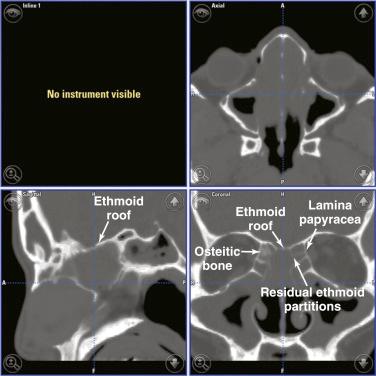Physical Address
304 North Cardinal St.
Dorchester Center, MA 02124
Completion sphenoethmoidectomy refers to a revision sinus procedure in a patient in whom a maxillary antrostomy and partial ethmoidectomy have been previously performed.
Patients with nasal polyposis and moderate to severe inflammatory disease commonly have persistent symptoms despite a partial ethmoidectomy and limited sinus surgery. Completion sphenoethmoidectomy is often combined with a frontal recess dissection in hopes that it will be the last surgery ever needed by the patient.
Often in these cases, there are remnant osteitic ethmoid bony partitions along the medial orbital wall and skull base that can be a source of persistent overlying mucosal inflammation ( Fig. 14.1 ).

Persistent inflammation in the bone and sinuses can often result in a bloody visual field. Surgeons must be careful and meticulous in their technique to achieve a safe and effective surgery.
Medical optimization should be accomplished.
Preoperative administration of an oral corticosteroid may lessen surgical difficulty both subjectively and in terms of blood loss.
Decongesting agents may be applied to minimize bleeding and facilitate surgical access. Options include the following:
Topical α-agonists, including pseudoephedrine, oxymetazoline, xylometazoline
Topical cocaine, 4%
Topical adrenaline, 1:1000
Computed tomography (CT) scans of the sinuses with coronal reformats should be available for review intraoperatively. Resolution should be at least 2 to 3 mm per slice.
Preoperative review of images is critical to identify danger areas, as detailed later.
Review preoperative CT scans.
Evaluate for the presence of bony dehiscences in the orbit and skull base.
Identify the depth of the lateral lamella to avoid inadvertent intracranial entry and cerebrospinal fluid (CSF) leak during dissection along the skull base.
Identify remnant ethmoid partitions along the medial orbital wall and skull base.
Identify the presence of a lateralized middle turbinate remnant.
Diagnose polypoid disease within the maxillary and/or sphenoid sinuses.
Evaluate the path of the anterior ethmoid artery as it courses between the orbit and the skull base. If it has a long course through the sinonasal cavity, it may be at risk of injury during ethmoid dissection along the ethmoid skull base. Retraction of the artery into the orbit may risk retro-orbital hematoma.
Identify the presence of Onodi cells, which are posteriorly pneumatized posterior ethmoid cells. Recognition of such cells is important, because the optic nerve may be dehiscent into these sinuses and vulnerable to injury. Equally important is evaluation of the skull base. Identification of a low-lying skull base or asymmetry is critical to avoid inadvertent injury.
Look for a short posterior ethmoid height, particularly in the context of a well pneumatized maxillary sinus. If the ratio of the maxillary sinus height to the height of the posterior ethmoid exceeds 2:1, the surgeon may be led erroneously on a trajectory to the skull base instead of the sphenoid sinus, which puts the patient at risk of CSF leak.
Identify bony dehiscences of the optic nerve and internal carotid artery in the sphenoid sinus.
Carotid dehiscences in the sphenoid sinuses have been found in 5% to 25% of cases in radiographic and cadaveric examinations.
Note the sphenoid intersinus septum. When the sphenoid sinuses are asymmetric, the intersinus septum typically attaches to the carotid canal on one side.
0- and 30-degree rigid endoscopes
Manual instruments
Straight and 90-degree J-curettes
Straight and 45-degree Blakesley forceps
Straight and 45-degree through-cutting forceps
Kerrison rongeur
Powered instruments
Straight and 40-degree microdébriders
Become a Clinical Tree membership for Full access and enjoy Unlimited articles
If you are a member. Log in here